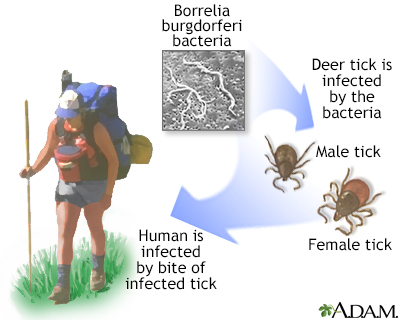Pregnancy SmartSiteTM
Borreliosis; Bannwarth syndrome DefinitionLyme disease is a bacterial infection that is spread through the bite of one of several types of ticks. CausesLyme disease is caused by bacteria called Borrelia burgdorferi (B burgdorferi). Blacklegged ticks (also called deer ticks) can carry these bacteria. Not all species of ticks can carry these bacteria. Immature ticks are called nymphs, and they are about the size of a pinhead. Nymphs pick up bacteria when they feed on small rodents, such as mice, infected with B burgdorferi. You can only get the disease if you are bitten by an infected tick.Lyme disease was first reported in the United States in 1977 in the town of Old Lyme, Connecticut. The same disease occurs in many parts of Europe and Asia. In the United States, most Lyme disease infections occur in the following areas:
There are three stages of Lyme disease.
Risk factors for Lyme disease include:
Important facts about tick bites and Lyme disease:
SymptomsSymptoms of early localized Lyme disease (stage 1) begin days or weeks after infection. They are similar to the flu and may include:
There may be a "bull's eye" rash, a flat or slightly raised red spot at the site of the tick bite. Often there is a clear area in the center. It can be large and expanding in size. This rash is called erythema migrans. Without treatment, it can last 4 weeks or longer. Symptoms may come and go. Untreated, the bacteria can spread to the brain, heart, and joints. Symptoms of early disseminated Lyme disease (stage 2) may occur weeks to months after the tick bite, and may include:
Symptoms of late disseminated Lyme disease (stage 3) can occur months or years after the infection. The most common symptoms are muscle and joint pain. Other symptoms may include:
Exams and TestsA blood test can be done to check for antibodies to the bacteria that cause Lyme disease. The most commonly used is the ELISA test for Lyme disease. An immunoblot test is done to confirm ELISA results. Be aware, though, in the early stage of infection, blood tests may be normal. Also, if you are treated with antibiotics in the early stage, your body may not make enough antibodies to be detected by blood tests. In areas where Lyme disease is more common, your health care provider may be able to diagnose early disseminated Lyme disease (Stage 2) without doing any lab tests. Other tests that may be done when the infection has spread include:
TreatmentPeople bitten by a tick should be watched closely for at least 30 days to see if a rash or symptoms develop. To prevent Lyme disease, a single dose of the antibiotic doxycycline may be given to someone soon after being bitten by a tick, when all of these conditions are true:
A 10-day to 4-week course of antibiotics is used to treat people who are diagnosed with Lyme disease, depending on the choice of medicine:
Pain medicines, such as ibuprofen, are sometimes prescribed for joint stiffness. Outlook (Prognosis)If diagnosed in the early stages, Lyme disease can be cured with antibiotics. Without treatment, complications involving the joints, heart, and nervous system can occur. But these symptoms are still treatable and curable. In rare cases, a person keeps having symptoms that interfere with daily life after they have been treated with antibiotics. This is also known as post-Lyme disease syndrome. The cause of this syndrome is unknown. Symptoms that occur after antibiotics are stopped may not be signs of active infection and may not respond to antibiotic treatment. Possible ComplicationsStage 3, or late disseminated, Lyme disease can cause long-term joint inflammation (Lyme arthritis) and heart rhythm problems. Brain and nervous system problems are also possible, and may include:
When to Contact a Medical ProfessionalContact your provider if you have:
PreventionTake precautions to avoid tick bites. Be extra careful during warmer months. When possible, avoid walking or hiking in the woods and areas with high grass. If you do walk or hike in these areas, take measures to prevent tick bites:
If a tick is attached to you, follow these steps to remove it:
ReferencesCenters for Disease Control and Prevention website. Lyme disease. www.cdc.gov/lyme. Updated May 15, 2024. Accessed June 18, 2024. Steere AC. Lyme disease (Lyme borreliosis) due to Borrelia burgdorferi. In: Bennett JE, Dolin R, Blaser MJ, eds. Mandell, Douglas, and Bennett's Principles and Practice of Infectious Diseases. 9th ed. Philadelphia, PA: Elsevier; 2020:chap 241. Wormser GP. Lyme disease. In: Goldman L, Cooney KA, eds. Goldman-Cecil Medicine. 27th ed. Philadelphia, PA: Elsevier; 2024:chap 296. | ||
| ||
Review Date: 3/16/2024 Reviewed By: Jatin M. Vyas, MD, PhD, Roy and Diana Vagelos Professor in Medicine, Columbia University Vagelos College of Physicians and Surgeons, Division of Infectious Diseases, Department of Medicine, New York, NY. Also reviewed by David C. Dugdale, MD, Medical Director, Brenda Conaway, Editorial Director, and the A.D.A.M. Editorial team. View References The information provided herein should not be used during any medical emergency or for the diagnosis or treatment of any medical condition. A licensed medical professional should be consulted for diagnosis and treatment of any and all medical conditions. Links to other sites are provided for information only -- they do not constitute endorsements of those other sites. No warranty of any kind, either expressed or implied, is made as to the accuracy, reliability, timeliness, or correctness of any translations made by a third-party service of the information provided herein into any other language. © 1997- A.D.A.M., a business unit of Ebix, Inc. Any duplication or distribution of the information contained herein is strictly prohibited. | ||


 Lyme disease organ...
Lyme disease organ... Tick - deer engorg...
Tick - deer engorg... Lyme disease - Bor...
Lyme disease - Bor... Tick, deer - adult...
Tick, deer - adult... Lyme disease
Lyme disease Lyme disease - ery...
Lyme disease - ery... Tertiary Lyme dise...
Tertiary Lyme dise...
